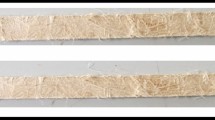Abstract
In order to explore the process of masterbatch dilution technique, the performance differences between poly(ethylene terephthalate) (PET) and PET/carbon black (CB) masterbatch were investigated. Scanning electron microscopy images of PET/CB masterbatch display a homogeneous dispersion status of CB particles in PET matrix. Besides, the improvement in heat resistance of masterbatch was confirmed by thermogravimetric analysis. The rheological measurement demonstrates that compared with PET the shear thinning effect of PET/CB masterbatch is more remarkable. The non-Newtonian index (n), activation energy of viscous flow (∆E) and structural viscosity index (∆η) can provide much important information for understanding the blending mechanism between PET and the masterbatch, which is valuable for spinning composite fiber with masterbatch dilution technique. According to the results of rheological measurement, the temperature is optimized to 280 °C and simultaneously the shear rate should be exceed to 1,150 s−1 on the basis of the theory of similarity and intermiscibility.







Similar content being viewed by others
References
Kim DJ, Seo AH, Hong KH, Kim SY (1999) Effects of dispersing agents on dispersity and mechanical properties of carbon black/PET. Polym Eng Sci 39:500
Jiang ZH, Jin J, Xiao CF, Li X (2011) Non-isothermal crystallization behavior of poly(ethylene terephthalate)/carbon black masterbatch. Polym Bull 67:1633
Li ZF, Luo GH, Wei F, Huang Y (2006) Microstructure of carbon nanotubes/PET conductive composites fibers and their properties. Compos Sci Technol 66:1022
Chae DW, Kim BC (2007) Thermal and rheological properties of highly concentrated PET composites with ferrite nanoparticles. Compos Sci Technol 67:1348
Jin SH, Park YB, Yoon KH (2007) Rheological and mechanical properties of surface modified multi-walled carbon nanotube-filled PET composite. Compos Sci Technol 67:3434
Wu DF, Zhou CX, Hong Z, Mao DL, Bian Z (2005) Study on rheological behaviour of poly(butylene terephthalate)/montmorillonite nanocomposites. Eur Polym J 41:2199
Jiang ZH, Jin J, Xiao CF, Li X (2012) Isothermal crystallization behavior of poly(ethylene terephthalate)/carbon black masterbatch. J Donghua Univ 29:123
Jiang ZH, Jin J, Xiao CF, Li X (2012) Effect of surface modification of carbon black (CB) on the morphology and crystallization of Poly(ethylene terephthalate)/CB masterbatch. Colloid Surf A-Physicochem Eng Asp 395:105
Lim YT, Par OO (2001) Phase morphology and rheologicalbehavior of polymer clay nanocomposites. Rheol Acta 40:220
Krishnammoorti R, Giannelis EP (1997) Rheology of endtethered polymer layered silicate nanocomposites. Macromolecules 30:4097
Girish G, Ramesh C, Ashish L (2001) A rheological study on the kinetics of hybrid formation in polypropylene nanocomposites. Macromolecules 34:852
Li J, Zhou CX, Wang G (2003) Study on rheological behavior of polypropylene clay nanocomposites. J Appl Polym Sci 89:3609
Li SD, Peng Z, Kong LX, Zhong JP (2006) Thermal degradation kinetics and morphology of natural rubber/silica nanocomposites. J Nanosci Nanotechnol 6:541
Du ML, Guo BC, Liu MX, Jia DM (2007) Thermal decomposition and oxidation ageing behavior of poly(propylene)/halloysite nanotube nanocomposites. Polym Polym Compos 15:265
Koo CM, Kim MJ, Choi MH, Ki SO, Chung IJ (2003) Mechanical and rheological properties of maleated polyproylene-layered silicate nanocomposites with different morphology. J Appl Polym Sci 88:1526
Auden WH (2003) Rheology of nanocomposites. The European Congress on advanced materials and processes, EUROMAT, September 1–5, 2003 in Lausanne (SFIT), Switzerland
Li J, Huang ZX, Zhang K (2011) Study on the thickening and rheological properties of crystalline polyester using in low pressure sheet molding compounds. Chin J Mech Eng 24:1
Acknowledgments
The authors gratefully acknowledge the financial support of doctoral scientific research funds of Shandong University of Technology (4041-403047) and Shandong province higher educational science and technology program (J14LA56).
Author information
Authors and Affiliations
Corresponding author
Rights and permissions
About this article
Cite this article
Jiang, Z., Jia, Z., Li, Z. et al. A comparative study of rheological behavior of PET and PET/carbon black composite masterbatch. Polym. Bull. 71, 3197–3208 (2014). https://doi.org/10.1007/s00289-014-1245-8
Received:
Revised:
Accepted:
Published:
Issue Date:
DOI: https://doi.org/10.1007/s00289-014-1245-8




